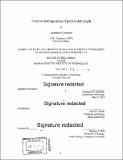| dc.contributor.advisor | David P. Bartel. | en_US |
| dc.contributor.author | Subtelny, Alexander O. (Alexander Orest) | en_US |
| dc.contributor.other | Massachusetts Institute of Technology. Department of Biology. | en_US |
| dc.date.accessioned | 2017-12-05T19:12:18Z | |
| dc.date.available | 2017-12-05T19:12:18Z | |
| dc.date.issued | 2014 | en_US |
| dc.identifier.uri | http://hdl.handle.net/1721.1/112426 | |
| dc.description | Thesis: Ph. D., Massachusetts Institute of Technology, Department of Biology, June 2014. | en_US |
| dc.description | Cataloged from PDF version of thesis. "May 2014." Vita. | en_US |
| dc.description | Includes bibliographical references. | en_US |
| dc.description.abstract | Poly(A) tails are found at the 3' ends of nearly all eukaryotic messenger RNAs (mRNAs) and long non-coding RNAs. The presence of a poly(A) tail promotes translation and inhibits decay of an mRNA, with both effects mediated through poly(A)-binding protein. However, an understanding of the relationship between the length of a poly(A) tail and these aspects of mRNA metabolism has been limited, primarily because of the lack of a technology that provides high-resolution poly(A)-tail length measurements in a global manner. This dissertation describes a new, high-throughput-sequencing-based method (PAL-seq) that measures the tails of individual mRNA molecules by coupling a fluorescence-based readout of poly(A)-tail length with sequencing of the poly(A)-proximal region. Using PAL-seq, we have found that poly(A)-tail lengths exhibit a notably poor correlation with translational efficiency (as measured by ribosome profiling) across genes in nearly all systems we have examined. In contrast, early zebrafish and Xenopus laevis embryos display a striking correlation (Spearman R > 0.6) that disappears at gastrulation. This developmental uncoupling of tail length and translational efficiency explains the different outcomes of microRNA (miRNA)-mediated poly(A)-tail shortening in zebrafish embryos before and after gastrulation, with translational repression being the predominant effect before and mRNA destabilization after. We have also observed that poly(A)-tail lengths do not correlate positively with mRNA half-lives in mammalian cells, and that miRNAs do not promote any apparent tail shortening in this setting. Since these results could be explained by differences in deadenylation rates, we performed a kinetic analysis in which we captured newly-made mRNAs of different age ranges. The deadenylation rates that we calculated after measuring tails over time correlated strongly with mRNA half-lives (Spearman R < -0.6), reinforcing the notion that tail shortening leads to mRNA downregulation. When we repeated the timecourse with prior overexpression of a miRNA, we found that miRNAmediated tail shortening was generally modest, but of a magnitude not significantly different from that expected given the accompanying decreases in mRNA stability. | en_US |
| dc.description.statementofresponsibility | by Alexander O. Subtelny. | en_US |
| dc.format.extent | 144 pages | en_US |
| dc.language.iso | eng | en_US |
| dc.publisher | Massachusetts Institute of Technology | en_US |
| dc.rights | MIT theses are protected by copyright. They may be viewed, downloaded, or printed from this source but further reproduction or distribution in any format is prohibited without written permission. | en_US |
| dc.rights.uri | http://dspace.mit.edu/handle/1721.1/7582 | en_US |
| dc.subject | Biology. | en_US |
| dc.title | Function and regulation of poly(A)-tail length | en_US |
| dc.type | Thesis | en_US |
| dc.description.degree | Ph. D. | en_US |
| dc.contributor.department | Massachusetts Institute of Technology. Department of Biology | |
| dc.identifier.oclc | 1008754763 | en_US |
